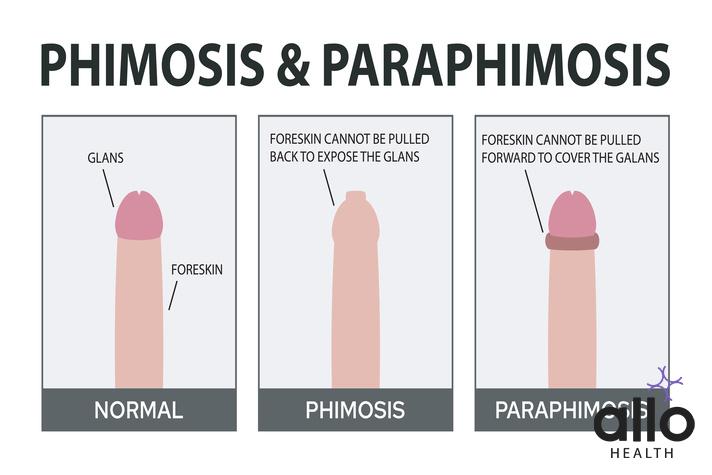Can A Man With Phimosis Make A Woman Pregnant?

Allo Health is dedicated to personalized well-being, offering support and trusted information tailored to individual health goals. The platform emphasizes human-generated content, led by a distinguished medical team of experts, including physicians and sexual health specialists. Their commitment to credibility involves rigorous fact-checking, authoritative research, and continuous updates to ensure accurate, up-to-date information. Allo Health's unique approach goes beyond conventional platforms, providing expert-led insights and a continuous commitment to excellence, with user feedback playing a crucial role in shaping the platform's authoritative voice.

Dr. Warisha holds an MBBS degree from GMERS Medical College, Ahmedabad. She has an in depth experience on sexual and reproductive health and rights.
Why This Was Upated?
Our experts continually monitor the health and wellness space, and we update our articles when new information became available.
Updated on 06 June, 2024
- Article was updated as part of our commitment to diversity, equity, and inclusion.

"The following blog article provides general information and insights on various topics. However, it is important to note that the information presented is not intended as professional advice in any specific field or area. The content of this blog is for general educational and informational purposes only.
Book consultation
The content should not be interpreted as endorsement, recommendation, or guarantee of any product, service, or information mentioned. Readers are solely responsible for the decisions and actions they take based on the information provided in this blog. It is essential to exercise individual judgment, critical thinking, and personal responsibility when applying or implementing any information or suggestions discussed in the blog."
Phimosis is a common condition among men in which the foreskin is too tight to be fully pulled back, causing discomfort during sexual activity and other related concerns. Many men who suffer from phimosis wonder if this condition has any impact on their fertility and ability to father a child. So, can a man with phimosis make a woman pregnant?
What Is Phimosis?
Phimosis is a condition that affects males, characterized by the inability to retract or pull back the foreskin of the penis. The foreskin is the fold of skin that covers the head of the penis, also known as the glans. Phimosis can occur in males of all ages, from infancy to adulthood.
There are two main types of phimosis:
- Physiological Phimosis: This is a normal condition commonly found in infants and young children. At birth, the foreskin is usually attached to the glans, and it gradually separates over time. It is common for infants to have a narrow foreskin opening, which makes it difficult to retract the foreskin. This is usually resolves naturally as the child grows older, and by the age of 3 to 5 years, most boys can fully retract their foreskin. Physiological phimosis does not require treatment in most cases.
- Pathological Phimosis: This is an abnormal condition where the foreskin remains tight and cannot be retracted even as the individual ages. It can be caused by various factors, including:
- Scarring or adhesions: Inflammation, infections, or repeated tearing of the foreskin can lead to scarring or adhesions, which restrict the foreskin’s movement.
- Balanitis: This refers to inflammation of the glans and foreskin. Repeated or severe episodes of balanitis can lead to scarring and tightness of the foreskin.
- Balanitis xerotica obliterans (BXO): BXO is a chronic, progressive condition that causes white, thickened patches on the foreskin and glans. These patches can lead to scarring and phimosis.
- Trauma: Injury or trauma to the foreskin can cause scarring and tightness, leading to phimosis.
- Other medical conditions: Certain medical conditions, such as lichen sclerosus or diabetes, can increase the risk of developing phimosis.
Phimosis can cause several concerns, including difficulty urinating, pain or discomfort during erections, inflammation, and recurrent infections. In severe cases, it may even cause problems with sexual intercourse.

Does Phimosis Affect Fertility?
Phimosis, in itself, does not directly affect fertility in men. Fertility refers to a man’s ability to father a child, which primarily depends on the production and quality of sperm. Phimosis, can indirectly impact fertility by causing difficulties or discomfort during sexual intercourse, ejaculation, or semen collection for fertility testing.
Here are some ways in which phimosis may affect fertility:
- Pain or discomfort during intercourse: In cases of pathological phimosis, where the foreskin is excessively tight and cannot be retracted, sexual intercourse may be painful or uncomfortable. This can lead to difficulties in achieving and maintaining an erection, as well as reduced sexual satisfaction. These factors can affect sexual performance and potentially impact fertility.
- Difficulty with ejaculation: Phimosis may interfere with the normal process of ejaculation. If the foreskin cannot retract fully, it may restrict the passage of semen during ejaculation. This can lead to concerns such as retrograde ejaculation (where semen enters the bladder instead of being expelled through the penis) or decreased volume of ejaculate, both of which can affect fertility.
- Increased risk of infections: Phimosis can make it more difficult to maintain proper genital hygiene, leading to an increased risk of infections, such as balanitis (inflammation of the glans and foreskin). Infections can cause inflammation and damage to the reproductive organs, potentially affecting sperm production and quality.
- Difficulty with semen analysis: When assessing male fertility, semen analysis is a common diagnostic test that evaluates various parameters of sperm, including count, motility, and morphology. Phimosis may make it challenging to collect an adequate semen sample for analysis. In such cases, alternative methods, such as using a special condom or performing a post-ejaculatory urine analysis, may be used.
How Phimosis Affects Sexual Intercourse and Conception
Phimosis can affect sexual intercourse and conception in several ways, primarily due to the difficulty in retracting the foreskin. Here are some details on how phimosis can impact these aspects:
- Pain or discomfort during intercourse: In cases of pathological phimosis, where the foreskin is too tight to retract, sexual intercourse can be painful or uncomfortable. The inability to fully expose the glans can lead to friction, irritation, and even tearing of the foreskin during penetration. This can cause discomfort or pain for both partners and may result in reduced sexual pleasure and satisfaction.
- Reduced sexual sensation: The inability to retract the foreskin may reduce sensitivity during sexual intercourse. The foreskin contains numerous nerve endings, and its movement during intercourse contributes to sexual stimulation. If the foreskin remains in a fixed position due to phimosis, it may limit the amount of sensation experienced during sexual activity.
- Difficulty achieving or maintaining an erection: Phimosis-related pain or discomfort during sexual activity can interfere with a man’s ability to achieve or sustain an erection. Psychological factors, such as anxiety or fear of pain, can also contribute to erectile difficulties. Erectile dysfunction can impact both sexual pleasure and the ability to engage in sexual intercourse successfully.
- Ejaculation concerns: Phimosis can interfere with the process of ejaculation. The tightness of the foreskin may restrict the passage of semen during ejaculation, resulting in discomfort or difficulty with the expulsion of semen. In some cases, it may cause retrograde ejaculation, where the semen enters the bladder instead of being expelled through the penis. These concernscan affect the chances of conception by reducing the delivery of sperm into the female reproductive tract.
- Reduced fertility potential: Although phimosis itself does not directly impact sperm production or quality, the aforementioned factors, such as pain, discomfort, and ejaculation difficulties, can indirectly affect fertility. If sexual intercourse becomes challenging or less frequent due to phimosis-related concerns, it may reduce the opportunities for conception. Additionally, any associated infections or inflammation resulting from poor hygiene or recurrent balanitis can potentially affect sperm function and reduce fertility.
Common Misconceptions about Phimosis and Male Fertility

- Misconception: Phimosis always leads to infertility.
Clarification: Phimosis itself does not directly cause infertility. While it can indirectly impact fertility by affecting sexual intercourse or ejaculation, the majority of men with phimosis do not experience fertility problems. Fertility is determined by the production and quality of sperm, which can be influenced by various factors unrelated to phimosis. - Misconception: Circumcision is the only solution for phimosis-related fertility concerns.
Clarification: Circumcision is a common treatment option for phimosis, particularly in cases where other treatments have failed or when recurrent concerns arise. It is not the only solution. Less invasive approaches, such as topical steroid creams or surgical techniques like preputioplasty or dorsal slit, can be effective in treating phimosis and addressing associated fertility concerns. - Misconception: All cases of phimosis require immediate treatment.
Clarification: Phimosis in infants and young children is usually physiological and typically resolves naturally as they grow older. It is considered normal during this stage and does not require immediate treatment. Only severe cases of pathological phimosis causing significant problems or discomfort may necessitate intervention. Each case should be evaluated by a healthcare professional to determine the appropriate course of action. - Misconception: Phimosis is always a result of poor hygiene.
Clarification: While maintaining good genital hygiene is important for overall health, phimosis can occur due to various factors unrelated to hygiene. Pathological phimosis can be caused by scarring, inflammation, infections, or other medical conditions. It is essential to understand that phimosis is not solely attributed to poor hygiene practices. - Misconception: Phimosis can never be resolved without surgery.
Clarification: Surgery is not always the first line of treatment for phimosis. In mild cases, conservative measures like gentle stretching exercises with topical steroid creams may be successful in resolving the condition. Additionally, as mentioned earlier, less invasive surgical procedures like preputioplasty or dorsal slit can be performed to address phimosis without completely removing the foreskin through circumcision.
Medical Procedures for Treating Phimosis and Improving Fertility
When phimosis is causing difficulties with sexual intercourse or fertility, medical procedures may be considered. The choice of procedure depends on the severity of the phimosis, the individual’s circumstances, and their preferences. Here are some medical procedures commonly used to treat phimosis and potentially improve fertility:
- Circumcision: Circumcision is the surgical removal of the foreskin. It is one of the most common treatments for phimosis. During the procedure, the entire foreskin is removed, exposing the glans. Circumcision is generally considered a definitive solution for phimosis, as it eliminates the narrowing of the foreskin and any associated problems. It is important to note that circumcision is irreversible.
- Preputioplasty: Preputioplasty is a surgical procedure that aims to widen the foreskin opening without removing the entire foreskin. It is often considered as an alternative to circumcision, preserving the natural appearance of the penis while addressing the tightness of the foreskin. In this procedure, a small incision is made in the tight area of the foreskin, and the edges are stitched together in a way that widens the opening.
- Dorsal slit: A dorsal slit is a surgical procedure where a vertical incision is made along the tight portion of the foreskin. This incision allows for easier retraction of the foreskin by effectively loosening its tightness. The procedure is typically performed under local anesthesia and is a less invasive alternative to circumcision or preputioplasty. The foreskin remains intact, and its appearance is largely preserved.
When to Seek Medical Help for Phimosis-Related Infertility
If you suspect that phimosis is contributing to fertility concerns, it is advisable to seek medical help. Here are some situations when it is appropriate to consult a healthcare professional regarding phimosis-related infertility:
- Inability to conceive: If you have been actively trying to conceive with your partner for a significant period (typically a year or more) without success, it may be beneficial to consult a reproductive specialist. They can evaluate both partners for potential fertility factors, including any possible impact of phimosis on male fertility.
- Persistent pain or discomfort during sexual intercourse: If phimosis is causing ongoing pain or discomfort during sexual activity, it is important to seek medical attention. Pain can significantly impact sexual satisfaction and may indicate the need for treatment to address the underlying phimosis and improve sexual function.
- Difficulty with ejaculation: If you experience difficulties with ejaculation, such as retrograde ejaculation (semen entering the bladder instead of being expelled through the penis) or reduced ejaculate volume, it may be related to phimosis. Consulting a healthcare professional can help determine the cause of these concerns and guide appropriate treatment.
- Recurrent infections or inflammation: If you frequently experience infections or inflammation of the foreskin or glans, it is important to seek medical help. Chronic or recurring balanitis (inflammation of the glans and foreskin) can impact fertility and may require medical intervention to address the underlying phimosis and prevent further complications.
- Impact on sexual function and quality of life: If phimosis is significantly affecting your sexual function, satisfaction, or overall quality of life, it is worth discussing with a healthcare professional. They can assess the severity of the phimosis, evaluate its impact on fertility-related aspects, and recommend appropriate treatment options.
Frequently Asked Questions
(1) Can phimosis affect a man’s ability to impregnate a woman?
Yes, phimosis can potentially affect a man’s ability to impregnate a woman. Phimosis refers to a condition where the foreskin is too tight and cannot be retracted fully. In severe cases, this tightness can hinder the proper exposure of the glans, making sexual intercourse difficult and potentially reducing the chances of conception.
(2) Is it possible for a man with phimosis to father a child?
Yes, it is still possible for a man with phimosis to father a child. While phimosis can pose challenges during sexual intercourse, it does not necessarily mean that conception cannot occur. If the man is able to ejaculate and the sperm is viable, pregnancy can still be achieved, although it may require extra effort and patience.
(3) Does phimosis affect sperm quality?
Phimosis itself does not directly affect sperm quality. If the condition causes pain or discomfort during sexual activity, it may lead to difficulties in achieving ejaculation. In such cases, sperm quality could be indirectly affected by decreased ejaculatory frequency. It’s worth noting that other factors, such as underlying health conditions or lifestyle choices, can also influence sperm quality.
(4) Can treating phimosis increase the chances of pregnancy?
Treating phimosis may improve the chances of pregnancy in some cases. By resolving the tightness of the foreskin through treatments like topical corticosteroids or surgical intervention (e.g., circumcision or preputioplasty), sexual intercourse can become more comfortable and potentially increase the likelihood of successful fertilization.
(5) Should a couple seek medical advice if phimosis is hindering conception?
Yes, if phimosis is causing difficulties in achieving pregnancy, it is advisable for the couple to seek medical advice. A healthcare professional can evaluate the severity of the condition and recommend appropriate treatment options. They may also suggest additional tests to assess other potential fertility factors in both partners, as infertility can sometimes be influenced by multiple factors unrelated to phimosis.
(6) Does phimosis affect the quantity of sperm a man can produce?
Phimosis itself does not directly affect the quantity of sperm a man can produce. The production of sperm occurs in the testes and is not influenced by the tightness of the foreskin. If phimosis causes pain or discomfort during ejaculation, it may lead to a reduced volume of ejaculate.
(7) Can phimosis cause infertility in men?
Phimosis does not necessarily cause infertility in men. While it may make conception more challenging, infertility is not a guaranteed outcome of the condition. Many men with phimosis are still able to father children. If phimosis is causing significant difficulties in achieving pregnancy, it is advisable to consult a healthcare professional for proper evaluation and guidance.
(8) Is it necessary to undergo surgery for phimosis to increase the chances of pregnancy?
Surgery is not always the only option to increase the chances of pregnancy in cases of phimosis. Non-surgical treatments such as topical corticosteroids or stretching exercises may be recommended as initial interventions. These approaches aim to gradually loosen the foreskin and alleviate the tightness. Surgery may be considered if non-surgical treatments are unsuccessful or if the severity of phimosis requires a more immediate resolution.
(9) Can phimosis be a contributing factor to male infertility?
Phimosis can potentially be a contributing factor to male infertility in certain cases. If the condition causes pain or discomfort during sexual intercourse or ejaculation, it may lead to difficulties in depositing sperm in the vagina. Additionally, if phimosis is accompanied by other fertility concerns, such as low sperm count or poor sperm motility, it could further decrease the chances of conception.
(10) Can phimosis be passed on to offspring?
Phimosis itself is not a hereditary condition. It is primarily caused by natural adhesions between the inner lining of the foreskin and the glans during infancy. Certain congenital conditions or genetic factors may predispose individuals to develop phimosis. It is advisable to seek medical advice if there are concerns about the potential transmission of phimosis to offspring, as a healthcare professional can provide personalized guidance and evaluate any underlying genetic factors.
Phimosis can have a significant impact on male fertility and chances of pregnancy. Seeking medical help and discussing treatment options is crucial for men struggling with this condition. By taking steps to manage and alleviate phimosis-related concerns, men can increase their chances of fathering a child and building a family.
It is important to note that phimosis can also be a risk factor for certain sexually transmitted infections (STIs). This is because the tight foreskin can make it difficult to properly clean the penis, leading to a buildup of bacteria and other harmful microorganisms. It is recommended that men with phimosis take extra care to maintain good hygiene and use protection during sexual activity to reduce their risk of contracting an STI.






































